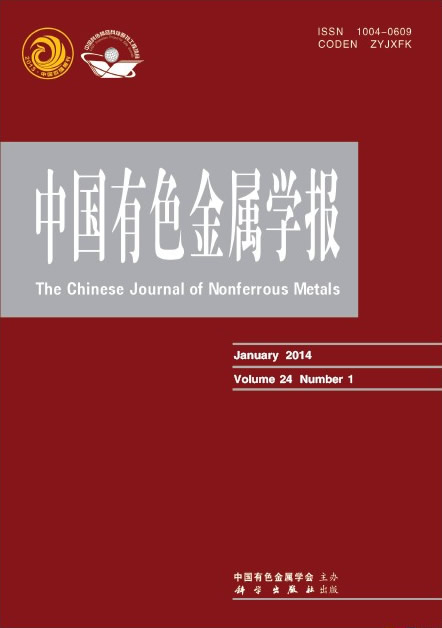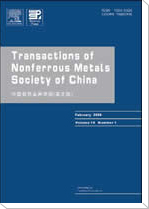(1. 中南大学 粉末冶金研究院,长沙 410083;
2. 中南大学 粉末冶金国家重点实验室,长沙 410083;
3. 哈尔滨工业大学 金属精密热加工国家级重点实验室,哈尔滨 150001;
4. 中南大学 材料科学与工程学院,长沙 410083)
摘 要: 利用Gleeble热模拟试验机对FGH96合金进行了等温压缩试验,获得了变形温度为1020~1110 ℃、应变速率为0.001~1 s-1范围内合金的流变应力数据,结合本构方程回归分析方法,计算不同变形条件下的Zener-Hollomon(Z)参数值;选取典型的Z参数条件,系统分析Z参数对FGH96合金热机械处理(热压缩变形和热处理)过程中微观组织和性能的影响,并在此基础上提出优化的锻造工艺参数。结果表明:随着Z参数的减小,热变形态合金的动态再结晶程度逐渐提高、动态再结晶晶粒尺寸有所增大,变形组织由混合组织向完全动态再结晶组织转变;不同Z参数下的形变储能以及γ′相的演化对热处理态合金的晶粒组织状态有重要影响。热变形态合金中二次γ′相在不同Z参数下均不同程度地溶解;随着Z参数的减小,二次γ′相经历了明显粗化到大量溶解的过程。在高Z参数和中等Z参数条件下,热处理态FGH96合金试样横截面的不同位置发生了明显的异常晶粒长大,合金的异常晶粒长大行为主要与变形条件(Z参数和应变量)、变形组织储能大小及分布以及γ′相的溶解行为有关。热变形态合金的维氏硬度值随Z参数的减小整体上呈现出明显的降低趋势,而热处理态合金的维氏硬度值保持在478~500 HV之间。综合考虑热机械处理过程中FGH96合金的组织和性能,选择Z参数为1.98×1015,即变形条件(1080 ℃,0.01 s-1)作为优化的锻造工艺参数。
关键字: FGH96合金;热机械处理;Z参数;动态再结晶;γ′相
(1. School of Aeronautics and Astronautics, Central South University, Changsha 410083, China;
2. State Key Laboratory For Powder Metallurgy, Central South University, Changsha 410083, China;
3. National Key Laboratory for Precision Hot Processing of Metals, Harbin Institute of Technology, Harbin150001, China;
4. School of Materials and Engineering, Central South University, Changsha 410083, China)
Abstract:Isothermal compression experiments of FGH96 alloy were carried out on a Gleeble thermal simulator. Flow stress data at the temperatures from 1020 ℃ to 1110 ℃ with strain rates from 0.001 s-1 to 1 s-1 were obtained. The values of Zener-Hollomon (Z) parameters under different deformation conditions were calculated by combining the regression analysis of constitutive equation. Typical Z parameter conditions were selected to systematically investigate the effects of Z parameter on the microstructure and properties of FGH96 alloy during thermo-mechanical treatment (hot compression deformation and heat treatment). The optimized parameters of hot forging process for the alloy were proposed on the basis of experimental data. The results show that with the decrease of Z parameter, both the degree of dynamic recrystallization (DRX) and the size of DRX grains for the hot-deformed alloys gradually increase, and the deformed microstructure transforms from a mixed state to a fully DRX state. The deformation energy storage and the evolution of γ′ phase under different Z parameters have important effects on the grain structure of the heat-treated alloys. The secondary γ′ phases in the hot-deformed alloys dissolve to different degrees at various Z parameters, and they undergo a process from obvious coarsening to massive dissolution with decreasing Z parameter. Under the conditions of high and medium Z parameters, obvious abnormal grain growth occurs at different positions of the cross sections of the heat-treated FGH96 alloy samples. The abnormal grain growth behavior of the alloy is mainly related to the deformation conditions (Z parameter and strain), the value and distribution of energy storage in the deformed microstructure and the dissolution behavior of γ′ phase. An apparently decreasing tendency of Vickers hardness is shown in the hot-deformed alloys with decreasing Z parameter, while the hardness values of the heat-treated alloys are kept in the range from 478 HV to 500 HV. Comprehensively considering the microstructure and properties of the FGH96 alloys during thermo-mechanical treatment, the optimized forging process parameter is selected to be at the Z parameter of about 1.98×1015, i.e. under the deformation condition of 1080 ℃ and 0.01 s-1.
Key words: FGH96 alloy; thermo-mechanical treatment; Z parameter; dynamic recrystallization; γ′ phase


